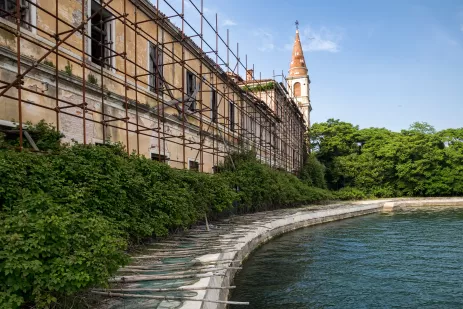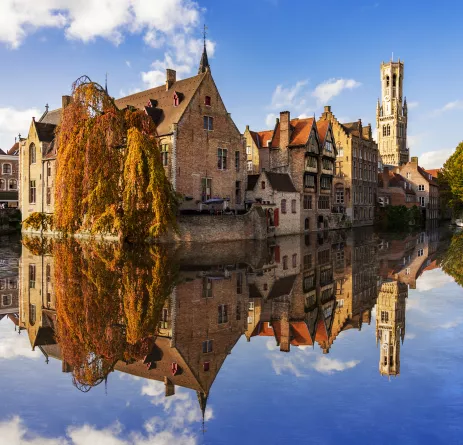The most haunted places in the world

Ever visited somewhere that makes the hairs on the back of your neck stand up? Walk through a cemetery and feel a cold chill? Have you seen something you can't explain? Whether you're looking for meaning or simply want a fun fright, our interest in the paranormal is a perfectly natural human impulse and when better to satisfy that need than Halloween?
All over the world, there are spooky sites ready to send a chill down your spine from old hospitals to gothic castles and underground dungeons. Here are some of the most haunted places you can visit on a Riviera Travel holiday.
Our spookiest destinations
LaLaurie Mansion, New Orleans, USA

For many, New Orleans is best known for Madi Gras beads, swinging jazz bands and revelry. What else would you expect from a city whose motto is laissez les bons temps rouler? But it's not all good times, New Orleans has a long history full of gruesome stories, creaky houses and shadowy cemeteries - there's a reason it's referred to as America's most haunted city.
Head to the historic French Quarter and you'll find landmarks like the LaLaurie Mansion. Legend has it, that during one of the LaLauries infamous parties, an enslaved woman was found chained to the stove in the kitchen after the smell of smoke alerted guests - she admitted to starting the fire herself. Concerned citizens flooded the mansion and uncovered a barred door in the attic. Inside was a torture chamber for those enslaved - some were chained to the walls, others had undergone ill-done surgeries - body parts were strewn across the floor. The citizens were furious. They charged after the LaLauries, but they'd escaped in a waiting carriage - it's said the ghosts of their victims began to appear immediately after.
We spend two days in New Orleans on our Deep South USA Plus Texas tour, including a day at leisure for you to explore the spooky side of this party city.
Catacombs, Paris, France

Under the chic streets of France's chic capital, in the subterranean depths, are more than 200 miles of Catacombs. Every twisting, turning tunnel is lined with the bones of long-dead Parisians. Given how dark and disorientating it can be down there, it's no wonder a few of the living have gotten lost down there amongst the dead over the years.
One such unfortunate soul to lose their way, and their life down there is Philibert Aspairt. Aspairt was working as the doorkeeper at the Val-de-Grace military hospital during the French Revolution, ventured down into the catacombs through the staircase from the hospital's courtyard and was never seen again - well, never seen alive again. It's not known why he went down there, although some suggest he was trying to break into the basement of a nearby brewery (yet another example in the lesson 'crime never pays'), lost the light and died slowly, in complete darkness. Because the tunnels are so long and so dark, his body was only found 11 years later - in a cruel twist of fate, he was only a few feet from an exit.
If we've not put you off with poor Philibert's story, you can visit the catacombs during time at leisure on our Paris tour (and, if you're nervous, don't worry, just stick close to a guide).
Devil's Pool, Cains, Australia

With a name like Devil's Pool, you'd expect there to be an unsettling reason behind the name - and you'd be right. In the middle of the lush Queensland rainforest of Australia is in Babinda Boulders with its a seemingly idyllic swimming hole. The sign in front of the picturesque pool is a muted sign warning people against venturing into the area.
According to Aboriginal folklore, a young woman named Oolana married an elder from her own tribe, the Yidinji. Shortly after their marriage, she fell in love with another man named Dyga from a touring tribe. The two lovers ran away and fled to what is now known as Devil's Pool where they were captured by the elders. Oolana broke free, and leapt into the creek, calling for Dyga to follow. Her voice shook the water into action. The land vibrated around her, sending boulders flying and water rushing killing her. People say that when Oolana's image appears in the water, her spirit pulls men into the waters believing them to be her lover. Since records began, Devil's Pool has claimed 17 lives, 16 of which were men.
You can visit Devil's Pool on our free day in Cairns in our Highlights of Australia tour.
Akershus Fortress, Oslo, Norway

Built in 1290 by King Håkon V to defend Norway from outside attacks, the castle was considered invincible and fended off many invaders. It was a burial site for several members of the Norwegian Royalty and it was also used as a prison. Screaming, whispering, scratching and chains rattling in the dungeon have all been heard by visitors. And while there are rumoured to be many unnamed ghosts residing in the castle, there are two that are more famous.
Malcanisen the Demon Dog is said to guard the gates of the fortress, anyone who sees him dies within three months - so if you spot him, you'd better get your affairs in order! It's rumoured that he was buried alive on the castle grounds - no wonder he's not happy. The other ghost roaming the halls of Akershus Fortress is Ole Høiland - the Norwegian Robin Hood - he was arrested several times for theft and became a legend thanks to his many escapes (he escaped 11 times). While he escaped from Akershus once - part of the prison is known as the Slaveriet, which means Slavery - prisoners in this part of the castle had to put up with extremely hard labour - and he committed suicide 3 years later.
You can plan a visit to Akershus during free time in Oslo on our holidays to Norway.
Poveglia Island, Venice, Italy

When it comes to this tiny island in the Venetian Lagoon, it's hard to distinguish between what is true and what is just local lore made up to scare tourists - but doesn't that make it all the more interesting?!
Poveglia first welcomed inhabitants in the 7th Century but was abandoned 7 centuries later due to extended conflict in the Chioggia War. It wasn't put to use again until the 18th century when Italy's Public Health Office began using it for customs control and later plague control. Ships that were noted to have cases of the plague aboard were forced to stop here. One of the many rumours suggests that to get rid of the plague-ravaged bodies, authorities burned the bodies of 100,000 victims (exact numbers differ) or were left in plague pits - adding to the idea that almost 505 of the island's earth is made of human remains.
Poveglia Island continued to be a quarantine station until the 20th century when it became a psychiatric hospital. As with many old psychiatric hospitals, rumours of inhuman experiments follow and, given its history, many stories suggest the patients of the hospital would see the ghosts of the plague victims during their time on shore. But the most chilling story is that of a doctor, who jumped to his death from the top of the clock tower after a sudden madness struck him. According to legend, it wasn't the fall that caused his death - it was a mysterious fog.
The island is still closed to visitors but you can see the bell tower - and the remains of the time-ravaged hospital - through the haze of the lagoon or from nearby Malamocco on Lido di Venezia, where the island’s unique crucifix of stucco and chalk is held.
Versailles, France

The residence of Louis XVI and Marie Antoinette (until the French Revolution quite literally cut their reign short) holds almost 400 years of history. So it's no wonder the opulent palace is said to hold its fair share of ghosts. But no story is told more than that of Anne Moberly and Eleanor Jourdain - two academics who claim to have experienced a timeslip.
In 1901, they were touring the palace on a three-week sightseeing tour and decided to visit the Petit Trianon - Marie Antoinette's personal Chateau. But on their way to the mini-chateau, they seemed to take a wrong turn (... into the past). According to their own accounts, they saw people on the grounds of the palace dressed in late 18th-century dress and landmarks that no longer existed - An 'evil-looking' man, they believed to be the Comte de Vaudriuel (an ambitious courtier Marie Antoinette despised- identified by his smallpox-marked face and creole features - servants and garden officials, they even claim to have seen Marie Antoinette herself sketching by the Petit Trianon.
Did they stumble into a timeslip - a haunting memory from the queen's last days of freedom - or just fall prey to the ghost hysteria sweeping popular culture at the time? You could find out for yourself on some of our favourite holidays to France.
La Recoleta Cemetery, Buenos Aires, Argentina

You might expect a few ghosts in a cemetery but nothing quite prepares you for La Recoleta. Built following the Argentine War for Independence (1810 - 1818) on the grounds of a disbanded monastery, it became an opulent new cemetery for the wealthy elites who erected eerie statues, crypts and mausoleums. And it's become an eccentric must-see attraction for any visitors to Buenos Aries.
There are a few ghost stories that linger around La Recoleta, but none is more chilling than that of the beautiful but misfortunate Rufina Cambaceres. In a tale that rivals Egard Allen Poe's 'The Premature Burial', when her family found Rufina's lifeless body on her 19th birthday in 1902, they were devastated. (The urban legend includes some spicier, yet uncorroborated details, such as Rufina fainting due to finding out her mother was having an affair with Rufina's fiancé.) Doctors pronounced her dead, she was put in her coffin, sealed in her family's mausoleum and a funeral was held. However, a few days after a cemetery worker found that the coffin had moved and the lid was broken inside - even worse, there were scratch marks, and Rufina dead inside had new bruises on her hands and face from having tried to beak her way out. Whether you believe this chilling tale or not, her tomb is a stunning Art Nouveau masterpiece- featuring a somewhat spooky full-sized statue of the misfortunate Rufina holding open the door to her own mausoleum - and the cemetery is a fascinating place to wander around (at least in the daylight). We visit La Recoleta Cemetery on a guided tour of Buenos Aires on of some of our holidays to South America.
Palazzo Dario, Venice, Italy

With a victim list longer than most serial killers, Palazzo Dario - also known as ‘The House that Kills’ - has more than earned its nickname. A palatial property overlooking the Grand Canal should be one of the most desirable spots in the city, yet the building has all but remained empty for almost 200 years. Built by Giovanni Dario, it didn't take long for the house to gain a reputation, Giovanni's daughter, Marietta, died by her own hand after the economic failure of her husband, Vincenzo - who also died violently after being stabbed - and their son also suffered a violent death in Crete during an ambush. This series of tragic events caused a sensation among Venetians.
Later, the Villa was sold to Arbit Abdoll, an American merchant of precious stones, who ended up in financial ruin too after taking possession of the house. Then Englishman Radon Brown, together with his partner, took their own lives after another financial meltdown and the (then) scandal of their homosexual relationship. Charles Briggs - an American - lost his lover after fleeing Venice. French Poet Henri de Regnier became so ill he couldn't return to Venice, famous tenor Mario del Monaco didn't even close negotiation before being involved in a serious car crash that forced him to relinquish the purchase. Count Filippo Giordano delle Lanze from Turin was killed by his lover in the house, his lover - who fled to London - was then also killed. In more recent history, Kit Lambert manager of the rock band The Who, died shortly after purchasing the house (he fell down the stairs in his London home). Financier Raul Gardini also took his life after financial setbacks and after only renting Ca'Dario for a week, bass player John Entwistle (The Who) died of a heart attack. Whether the house is cursed or this is just a (very long) string of terrible and sad events remains a mystery, but the tragic events have definitely caught the imagination of the locals. You can go in search of Palazzo Dario on some of our holidays to Italy.
Bruges, Belgium

Bruges has lots to endear it to a discerning traveller - medieval buildings, romantic squares, pretty canals and world-class art. But it also has one thing that's not on everyone's holiday wish list: ghosts.
Bruges dates back to the 9th century - it was founded by the Vikings - so there's plenty of history to unpack here and it's seen its fair share of tragedy and death but ask the locals and there's only one story they'll tell you. In 1498, there used to be a nunnery near the river Reie - in the house Den Noodts Gods, and on the opposite side, an Augustine Monastery. So the legend goes, a monk from the monastery fell in love with a nun named Hortence and when he found out there was an old tunnel that connected the two, he used to secretly visit her. When Hortence decided she no longer wanted anything to do with the monk, she tried to run away and out of vengeance, he killed her and hid her body beneath the cellar (clearly he didn’t take rejection well). Their souls are said to still wander around Den Noodt Gods - her ghost is said to appear as a snowy white figure and his ghost appears with a grim face searching for her to ask forgiveness - the story is so famous that the locals often just call Den Noodt Gods, Spookhuis or 'the haunted house'. We visit Burges on our holidays to Belgium.
Whether you're interested in the macabre or not, these stories offer an interesting insight into the history and culture of each destination - like a window into its very soul. And if these destinations don't take your fancy, there are plenty more to choose from.















